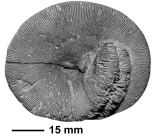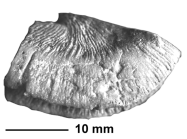
| Intro | | About | | Wiki | | Search traits | | Data explorer | | Literature | | Definitions | | Sources | | Webservices | | Statistics | | Feedback | | Editors | | Log in |
WoRMS taxon detailsDiploctenium Goldfuss, 1826 †
1437836 (urn:lsid:marinespecies.org:taxname:1437836)
accepted
Genus
Diploctenium cordatum Goldfuss, 1826 † (type by original designation)
marine,
fossil only
Goldfuss, G. A. (1826-1833). Petrefacta Germaniae tam ea, quae in Museo Universitatis Regiae Borussicae Fridericiae Wilhelmiae Rhenanae servantur quam alia quaecunque in Museis Hoeninghusiano, Muensteriano aliisque extant, iconibus et descriptionibus illustrata. Erster Theil. (Arnz & Comp.: Düsseldorf): 1-252, pls I-LXXI. [I-VIII, 1-76, pls. 1-25 (1826); 77-164, pls. 26-50 (1829); 165-240, pls. 51-71, 1 unnumbered plate (1831); 241-252 (1833)] [publication dates from: Quenstedt, W. (1963). Clavis bibliographica. In: Westphal, F. (ed.), Fossilium Catalogus, I. Animalia, pars 102. 118 pp. s'Gravenhage: Junk.]. , available online at https://biodiversitylibrary.org/page/50235037 [details]
Hoeksema, B. W.; Cairns, S. (2024). World List of Scleractinia. Diploctenium Goldfuss, 1826 †. Accessed through: World Register of Marine Species at: https://www.marinespecies.org/aphia.php?p=taxdetails&id=1437836 on 2024-05-03
Date action by
original description
Goldfuss, G. A. (1826-1833). Petrefacta Germaniae tam ea, quae in Museo Universitatis Regiae Borussicae Fridericiae Wilhelmiae Rhenanae servantur quam alia quaecunque in Museis Hoeninghusiano, Muensteriano aliisque extant, iconibus et descriptionibus illustrata. Erster Theil. (Arnz & Comp.: Düsseldorf): 1-252, pls I-LXXI. [I-VIII, 1-76, pls. 1-25 (1826); 77-164, pls. 26-50 (1829); 165-240, pls. 51-71, 1 unnumbered plate (1831); 241-252 (1833)] [publication dates from: Quenstedt, W. (1963). Clavis bibliographica. In: Westphal, F. (ed.), Fossilium Catalogus, I. Animalia, pars 102. 118 pp. s'Gravenhage: Junk.]. , available online at https://biodiversitylibrary.org/page/50235037 [details]
basis of record Milne Edwards H, Haime J. (1857). Histoire naturelle des coralliaires ou polypes proprement dits 2. Librairie Encyclopédique de Roret, Paris. 631 pp., available online at https://www.biodiversitylibrary.org/page/12403706 [details] additional source Duncan PM (1884) A revision of the families and genera of the sclerodermic Zoantharia, Ed. & H., or Madreporaria (M. Rugosa excepted). Journal of the Linnean Society of London, 18: 1-204. [details] additional source Oppenheim P. (1930). Die Anthozoen der Gosauschichten in der Ostalpen. <em>Oppenheim, Berlin-Lichterfelde.</em> i-xviii, 1-576. [details]  Present Present  Inaccurate Inaccurate  Introduced: alien Introduced: alien  Containing type locality Containing type locality
From editor or global species database
Diagnosis Colonial, pedunculated, flabelloid. Calicular series inclined or curved towards the base, in some cases the ends of the series meet or even pass each other. Costosepta compact, finely granulated laterally. Costae bifurcating and trifurcating. Columella lamellar, continuous. endothecal dissepiments few in number, vesicular. Wall septothecal, forming a stereozone. [details]Remark Bendukidze (1956, 1965) studied the stages of ontogeny of specimens of Diploctenium lunatum (Bruguiere). She concluded that skeletal elements and their dimensions in this species are directly dependent upon environment. Moreover, within the same specimen each stage of ontogeny closely corresponds to a different nominal species of Diploctenium. These results completely agree with investigations on ontogenetical stages of specimens of Diploctenium from the Santonian of Austria (Gosau Group) carried out by Baron-Szabo (2003). Based on the results of these investigations it can be concluded that stable specific characters are reflected in the density of septa and number of septal orders in relation to the width of the calicinal series. [details] |



